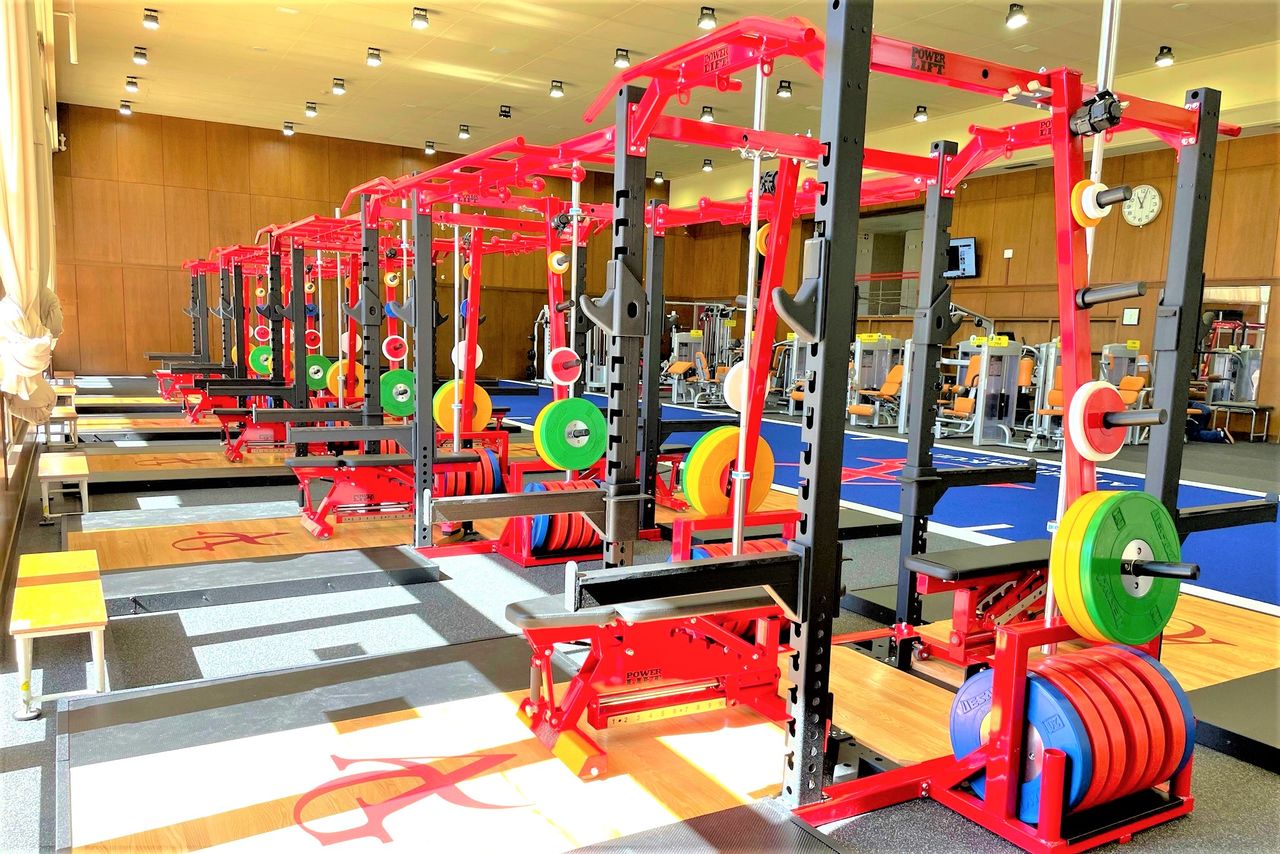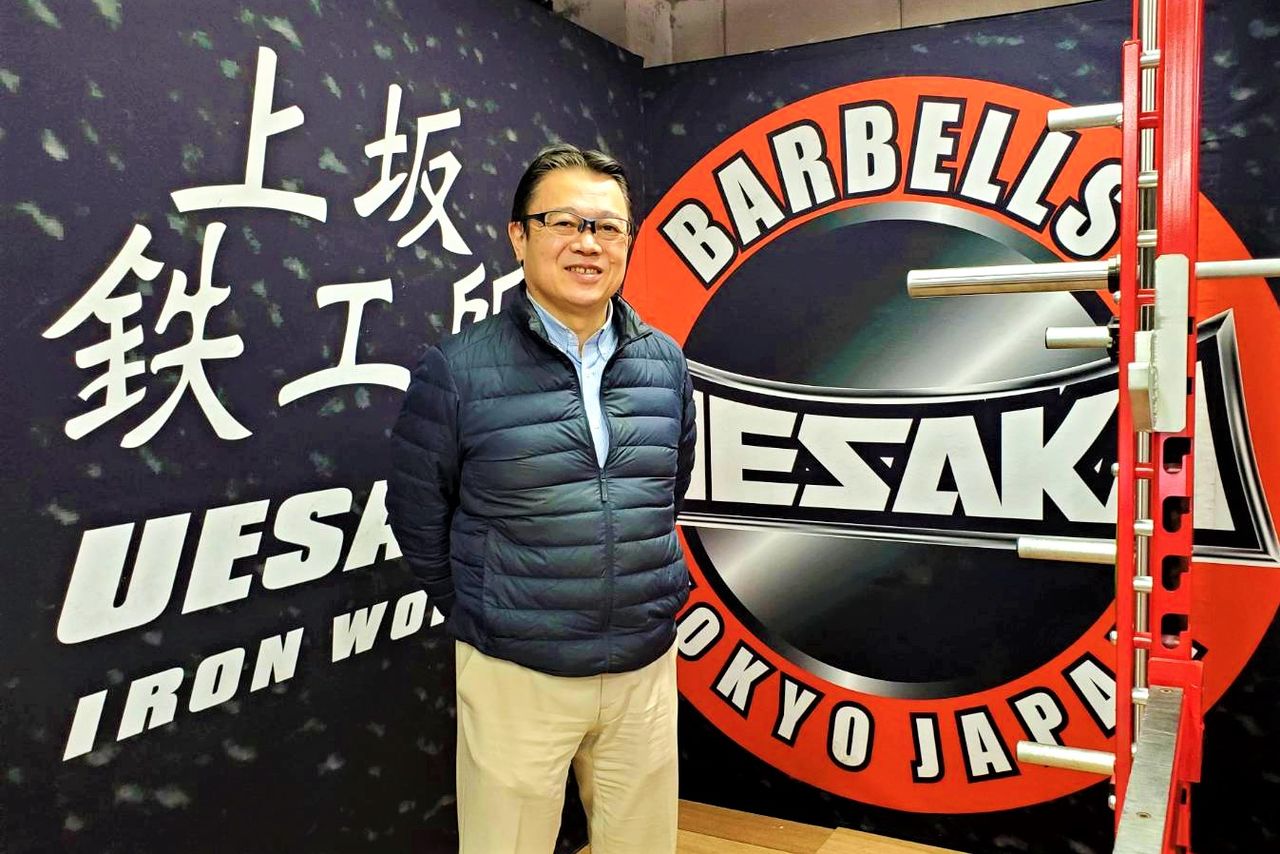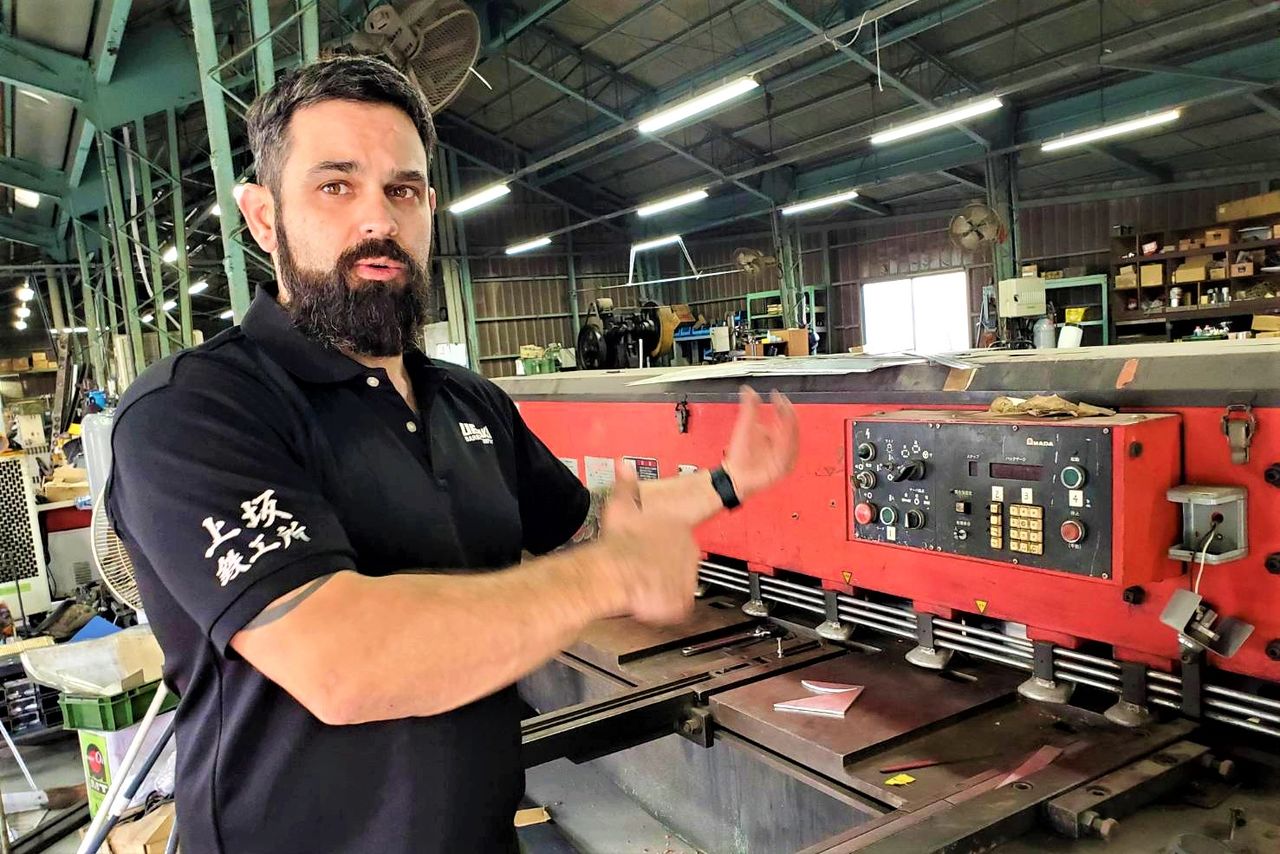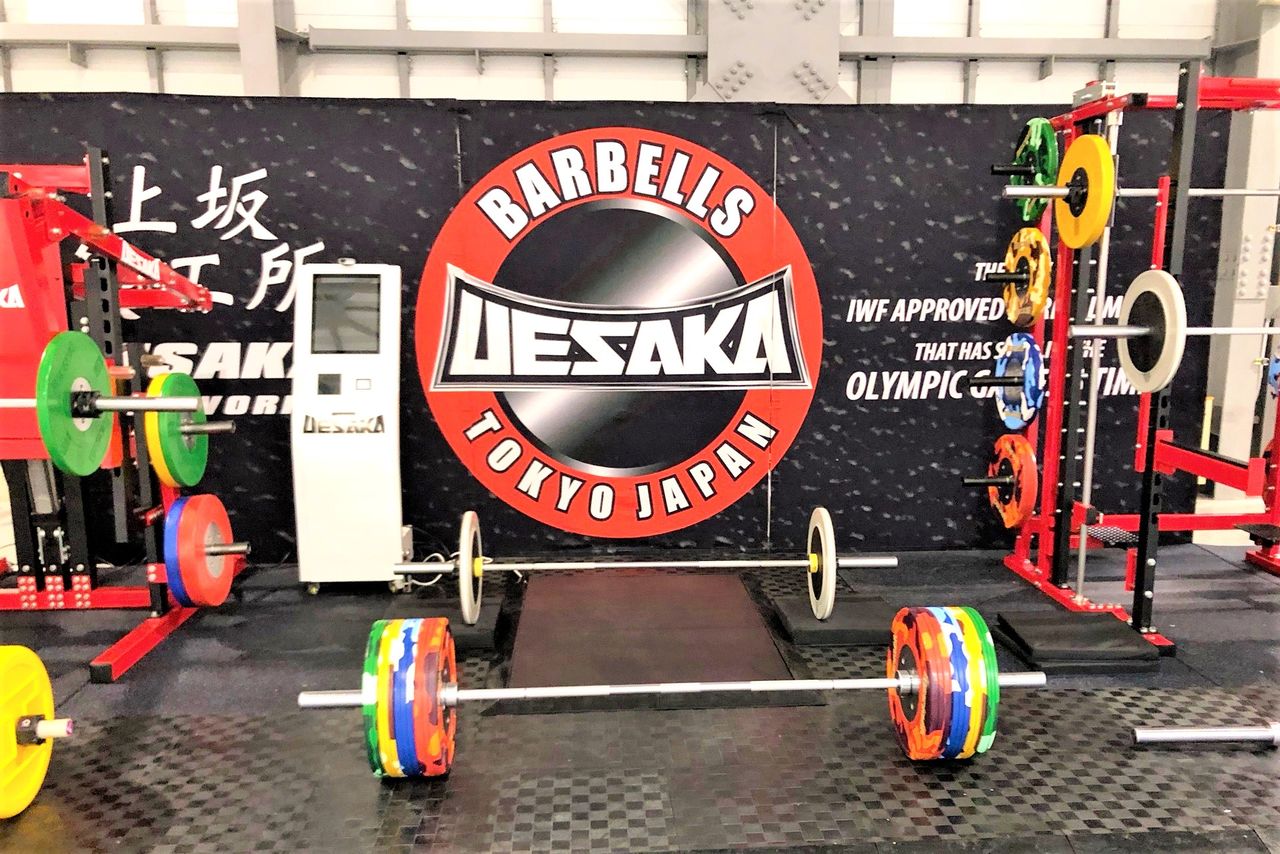
Japan’s Innovations in the Sporting World
Uesaka: The Family Firm Behind the World’s Best Barbells
Economy Sports- English
- 日本語
- 简体字
- 繁體字
- Français
- Español
- العربية
- Русский
From Tokyo’s “Low Town” to the Highest Levels of Competition
Lying in the shadow of the iconic Tokyo Skytree tower, the Honjo area of Tokyo’s Sumida lies at the heart of the capital’s atmospheric “low town” shitamachi district. The area is home to countless family-run businesses and small-scale machi kōba (“neighborhood workshops,” as they are called in Japanese) that have made an important contribution to small-scale manufacturing and have propelled and maintained Japan’s reputation for world-class craftsmanship and quality manufacturing in a wide range of industries.
One of these companies is Uesaka T.E., one of the world’s leading manufacturers of weightlifting barbells. The company’s equipment has been used in weightlifting events at no fewer than six Olympics, dating back to the Tokyo Games in 1964. (The company’s barbells were also used at Seoul in 1988, Barcelona in 1992, Atlanta in 1996, Sydney in 2000, and Athens in 2004.) Their equipment is also a fixture in the training gyms of professional teams in many other sports, including English Premier League soccer champions Manchester City and Japanese baseball teams like the Fukuoka SoftBank Hawks and the Yomiuri Giants. Synonymous with barbells, the Uesaka name is familiar to weightlifters and other athletes serious about strength training throughout the world.

Some of Uesaka’s equipment in use at Aichi Gakuin University. (Courtesy of Uesaka)
The predecessor of the present company was founded as Uesaka Tekkōjo (Ironworks) in 1929. The company’s founder, Uesaka Kyūsaka, came to Tokyo from his hometown in Toyama Prefecture and started a company that produced metal parts for the construction industry. Four years later, he branched out and started producing sporting equipment. It was in 1947, shortly after the end of World War II, that he received the order that would have a decisive impact on the future of the company. Uesaka was approached one day by a representative of the US forces then occupying Japan, who wanted 300 sets of barbells for training purposes.
Barbells were not widely known or used in Japan at the time, and Uesaka’s company had never produced a set before. Making the barbells proved to be much more difficult than anyone at the company had imagined. The nature of weightlifting meant that the barbells were often flung to the ground forcefully, causing the shaft to break or bend under the strain. Coming up with barbells that could withstand these shocks involved all kinds of technical challenges. Kyūsaku and his team uncomplainingly started burning the midnight oil to solve the challenge they had been set.
Their hard work was not in vain. In 1953, the company was recognized as an officially certified manufacturer by the Japanese Weightlifting Association, and in 1958 the company’s barbells were used at the third Asian Games, held in Tokyo.
The Asian Games organizers had ordered 30 sets for the weightlifting competition, hoping to ensure there would be enough on hand even if parts broke or otherwise failed. In the end, though, they had to admit this had been a mistake—the Uesaka barbells proved perfectly reliable, with a single set making it through the entire competition schedule. With this, Uesaka had shown the top quality of its products, and its reputation was made among leading weightlifters from throughout Japan and around the Asian region.
Japan was entering a major boom period, fueled by rapid economic growth. In 1964, the Olympics came to Tokyo. By this time, Uesaka had developed a reputation as one of Japan’s leading manufacturers of sporting equipment. This major event allowed the company to boost its presence on the global stage. Uesaka was hired to help set up and run the venues for events in four categories: weightlifting, athletics, swimming, and boxing. The company made an important contribution to the success of the Olympic games.
Unfortunately, the company’s founder did not live to see this moment of glory. Kyūsaku, who had built his company into one of the leaders in its field, passed away two years before the Tokyo Olympics. Uesaka Tadamasa, today the company’s third-generation president, was born shortly after this loss. Tadamasa has no personal memory of the Tokyo Olympics, but remembers the stories his parents told him about this pivotal time in the company’s history.
“They tell me I was there for the opening ceremony. I was two years old at the time, and apparently watched the ceremony in my mother’s arms from a seat in the old National Stadium. That was a busy time for the company. We helped produce and set up all kinds of equipment for the Games, from the diving boards to the netting enclosures for the throwing events and starting blocks for the sprints. At the time, the ropes used to divide the lanes in the swimming pools were made of wood. I remember my mother telling me how she helped give the pieces of wood a protective layer of paint.”
A boom period followed for the company, as Japan’s economic growth drove demand for sporting equipment of all kinds.
“The baby boom boosted the number of schools, and that led to a huge increase in the demand for all kinds of sporting goods. Vaulting boxes, mats, volleyball nets and poles, you name it. The demand seemed to visibly increase almost day-by-day. My father was the president of the company in those days, and he rode that wave. The company expanded until we were producing just about every kind of sporting equipment you can imagine. It wasn’t just schools. There was also demand for equipment for corporate athletic facilities. It’d be little exaggeration to say that in those days you could find our equipment inside just about every one of those places.”
Narrowing the Focus to Barbells
But no growth lasts forever. By the 1990s, concerns were being raised about the declining birthrate and Japan’s graying population. Tadamasa took over as company president in 1996. The next year, the number of elderly people in Japan overtook the number of children for the first time.
Tadamasa decided it was time for a new start. On March 26, 1996, the company was reborn as Uesaka T.E. Tadamasa also resolved to depart from the expansionist course his father had followed, at the end of which the company was making more than 2,000 different products. From now on, he decided, Uesaka would specialize. The aim was to become a leading brand in a narrower field.

Uesaka Tadamasa, third-generation head of the family-run company, spends much of his time traveling to visit customers around the country and farther afield. (© Kumazaki Takashi)
The product on which Tadamasa decided to pin the company’s future was the same one his grandfather had worked so hard to produce in the 1940s. His mind was made up. The new-look Uesaka would specialize in barbells and carve out a niche for itself as a leader in that field.
Out of all the sporting equipment produced by the company at that time, why decide to specialize in barbells, which were hardly an item of everyday familiarity to most people in Japan, then or now?
Tadamasa is ready with an answer. “Weightlifting involves movements that are basic to all sports. That’s one of the things that makes it such a superb form of training. And although it may be a minor interest in Japan, in the United States it’s quite mainstream.”
Tadamasa continues by talking about his memories of the 1996 Atlanta Olympics, where Uesaka’s equipment was again used in the weightlifting events.
“In Japan, weightlifting is something you sit down and watch quietly. You might give a round of applause if the athlete makes a successful lift. In America, it’s totally different. Even at the Olympics, they were playing loud music and a huge cheer would go up every time an athlete entered the arena. Partly that’s due to the more exuberant character of the American people, I suppose. But it’s also because training with barbells is so much more deeply rooted in the culture over there. Seeing that competition live in Atlanta really brought home to me the size of the American market.”
Tadamasa returned from Atlanta filled with new confidence in the company’s new direction. In autumn that year, a few months after his return to Japan, he received a check from a specialist at the University of Nebraska.
The person who had sent the check was Boyd Epley, a well-known coach and strength-training expert who oversaw athletic conditioning programs at the University of Nebraska. He had experienced Uesaka’s barbells for the first time at Atlanta, and wrote to say how impressed he had been by the quality of the company’s products.
“Boyd said how impressed he was with the shafts of the barbells. In weightlifting, you use a concentrated explosion of strength to lift the barbell and catch it above your head. The athlete uses the principle of inertia to lift and throw the shaft into position. Just like swinging a golf club or fishing rod, it’s essential to have that pliability in the shaft, to produce that explosive speed and power.”
If that pliancy is still there at the moment of the catch, though, there’s a risk, notes Uesaka: “That momentum is going to carry the lifter’s upper-body weight with it. You want to have pliability and bend at the instant when the lifter grabs and throws the bar, but then that needs to stop dead at the instant of the catch. With our barbells, the shafts are produced using a secret formula that ensures that they are neither too soft nor too hard. They offer outstanding balance and ease of control. It was these qualities that Coach Boyd recognized and wrote to compliment us on.”
What Makes Uesaka Special
Not surprisingly, there are numerous Uesaka enthusiasts among the athletic and weightlifting communities.
One of the employees at the factory in Koshigaya, Saitama, where the company produces barbell plates, is Anastasios Pappas, originally from Greece. He got to know Tadamasa at the Athens Olympics in 2004. He was studying Japanese at the time, and came to Japan in 2009 to marry his Japanese girlfriend. He started working for Uesaka soon after and has never looked back.

Anastasios Pappas was once an Uesaka fan, and is now an employee. (© Kumazaki Takashi)
Tadamasa says he first recruited Pappas to work at the company because he was a weightlifter himself who had finished in third place in the national championships in Greece, a major hotbed of the sport, and because he had built up a network of contacts in weightlifting organizations around the world.
Because top-class lifters are sensitive to even slight differences in weight, Uesaka calibrates the weight of its shafts with tremendous precision, and aims for zero margin of error in the weight and heft in each individual shaft. This is another reason why the company’s equipment has proved so popular with competitive lifters. Pappas notes that one of his inspirations, a legend in the world of weightlifting, apparently attributed much of his success to the outstanding quality of Uesaka’s barbells.
“Pyrros Dimas is a national hero in Greece. He competed at four Olympics, winning three gold medals and one bronze. And he won all those medals using Uesaka barbells. He told me: ‘This success is not only due to me. It was thanks to Uesaka that I was able to lift using 100% of my strength.”
As it happened, the Athens Games marked the end of Uesaka’s association with the Olympics. This was certainly not the result of any drop in the quality of the company’s products, though.
From the time of the 2008 Beijing Games, the trend toward commercialization of the Olympics became more pronounced, and in many events it became commonplace for equipment makers to be chosen not on the grounds of quality but according to the amount of financial support that manufacturers were prepared to give to the sport’s organizing bodies. Despite the lip service given to the idea of “athletes first,” sports were becoming increasing dominated by a “business first” way of thinking. As a small family-run company, Uesaka was in no position to compete financially against the global giants.

The Uesaka booth at a trade fair. Today, the company produces and sells a variety of training equipment, with a focus on barbells for weightlifting. (Courtesy of Uesaka)
Thriving During the Pandemic
Even so, Uesaka has gone from strength to strength. When Tadamasa took over the company, he inherited a brand that was respected by aficionados but not widely known outside specialist circles. Its reputation has since grown rapidly around the world, and the company now enjoys a particularly prominent profile in the United States.
“Even during the pandemic, our sales in the United States went up,” Tadamasa says.
The reason? During the pandemic, a lot of weightlifting enthusiasts took to improving their garage gyms and training at home. As Boyd and others said for many years, barbells are an extremely efficient training tool. They are also much more affordable than weight machines and take up less space.
In Japan, too, increasing numbers of sports teams and schools are buying barbells. The country remains some way behind the United States when it comes to popular interest in the training method, but the number of enthusiasts looking to build home gyms is also increasing steadily, and Tadamasa, Pappas, and their colleagues are busy most days traveling throughout the country helping customers to set up their new equipment. Ever since Tadamasa’s grandfather filled his first order for barbells in the postwar occupation days, Uesaka’s approach has been built on the idea of putting the athlete first. Today, the company and its barbells continue to support the health and fitness of professional athletes and amateur enthusiasts alike.
(Originally published in Japanese. Banner photo: Uesaka’s barbells are used at the Japan Weightlifting Championships. Pictured here is Itokazu Yōichi, who placed fourth at the Olympics in Rio de Janeiro. Taken on December 11, 2020, in Niigata. © Jiji.)
sports business Olympics manufacturing Weightlifting barbell